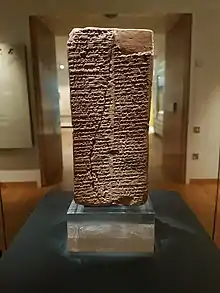Weld-Blundell Prism
The Weld-Blundell Prism is a clay, cuneiform inscribed vertical prism housed in the Ashmolean Museum. The prism was found in a 1922 expedition in modern day Iraq by British archaeologist Herbert Weld Blundell.[1] The four sides, about 20 cm high and 9 cm wide, are inscribed in the Sumerian language with lists of Sumerian kings; each side contains the text in two columns: this is the famous Sumerian King List.

The list begins with the antediluvian rulers and ends with Sin-magir of the Isin dynasty (r. 1827–1817). The list was most likely written in Sin-magir's final year, or soon after.[2] Many, especially antediluvian, kings are credited with incredibly long reigns (counted in sars and nerah), as a result of which many scholars consider this work to be more artistic than historical.[1]
Various theories are being constructed in an attempt to explain such large numbers. They are supposed to express the great importance of rulers who were considered semi- gods . According to another version, sar (3600 years) and ner (600 years), the units of time measurement in the Sumerian number system, should be taken as years and months, respectively.[3]
The museum number is AN1923.444.
See also
References
- "Weld-Blundell Prism". University of Oxford - Ashmolean Museum.
- Van De Mieroop, Marc (2016). A History of the Ancient Near East (3rd ed.). Oxford: Wiley Blackwell. p. 47.
- "Kingdoms of Mesopotamia - Sumer". The History Files.